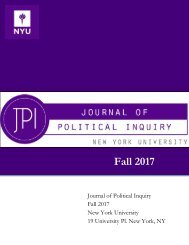JPI Spring 2018
You also want an ePaper? Increase the reach of your titles
YUMPU automatically turns print PDFs into web optimized ePapers that Google loves.
them. Figure 4 below shows that raising traditional sources of state tax revenue—such as personal<br />
income tax, sales tax, and corporate income tax—was not common in the years preceding the<br />
Recession. As Campbell and Sances point out, between only 10 and 20 percent of states raised these<br />
taxes. 17 In contrast, the lower three panels of the graph show that between 20 and 50 percent of states<br />
raised “other” taxes—a category they indicate includes alcohol, tobacco, and gasoline taxes—and<br />
between 20 and 40 percent of state fees. States also clearly dipped into reserves, which 46 out of 50<br />
states had at the start of the Recession. 18 About half of these states drew on those funds in the peak<br />
year of the Recession.<br />
The implication here is obvious. Although with the data presented one cannot assume that<br />
policy makers abused their state budgets as a result of falling labor rates, it is clear that the discrepancy<br />
was mishandled - the question is why. The traditional forms of revenue production mentioned—<br />
raising income tax, sales tax, and corporate income tax—all have policy (and re-election) implications<br />
for a state legislator or politician. Raising the tax on cigarettes and alcohol holds significance in a<br />
different way than increasing the overall sales tax - raising income and corporate tax is a highly<br />
politicized issue in every single election, regardless of political party or agenda. 2008 was a Presidential<br />
and Senatorial election year. In 2006, two years before the Recession, Congressional seats were up for<br />
re-election in every state. We do not need regression analysis to tell us why congressmen shied away<br />
from increasing the appropriate tax measures to re-balance their state budgets a year or two before<br />
they faced re-election. We see here though that, like Germany, both the conditions of political control<br />
and budget and labor shortfalls were present in the years leading up to the crisis.<br />
Many argue that de-regulation in 1982 was the seed of the financial crisis with the passing of<br />
the Garn-St. Germain Depository Institutions Act. This removed restrictions on loan-to-value ratios<br />
for banks, which lenders and others used to understand how risky a loan was. It is also utilized for<br />
approving loans or requiring mortgage insurance. However, the early eighties brought a period of<br />
economic “revolution” with President Reagan’s trickle-down policies. The economy appeared to be<br />
improving by deregulation and the idea that allowing for more money at the upper echelons of the<br />
economy would eventually have a rippling effect on the rest of the country. Many argue though that<br />
this period facilitated imbalanced budgets, reckless lending, and overall structural weaknesses that led<br />
to the collapse of the U.S. financial system almost 20 years later. 19<br />
17<br />
Andrea Louise Campbell and Michael W. Sances, “State Fiscal Policy during the Great Recession,” The ANNALS of the American Academy of<br />
Political and Social Science vol. 650, no. 1 (2013): 252–273. doi:10.1177/0002716213500459.<br />
18<br />
Campbell and Sances.<br />
19<br />
Campbell and Sances.<br />
<strong>JPI</strong> Fall 2017, pg. 34
















